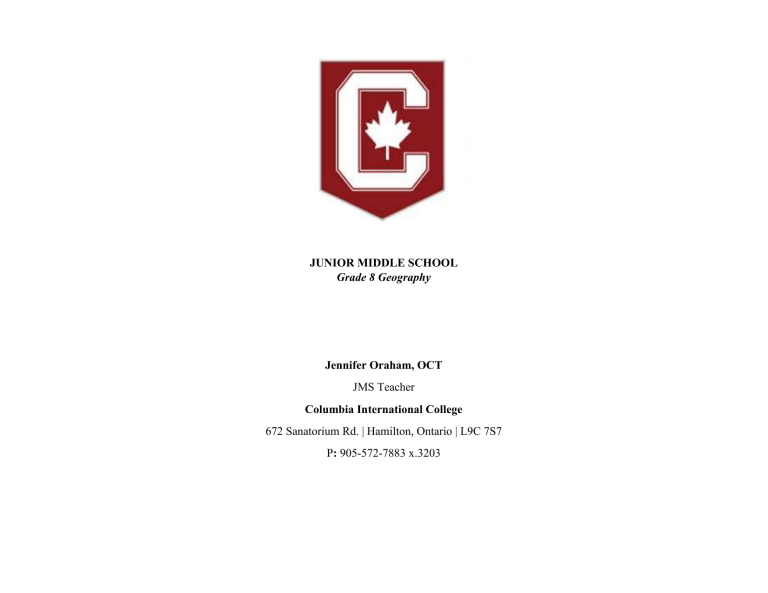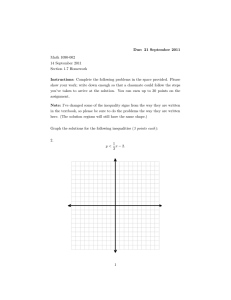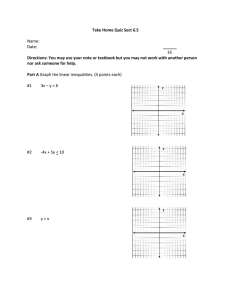Grade 8 Geography Course Outline
advertisement

JUNIOR MIDDLE SCHOOL Grade 8 Geography Jennifer Oraham, OCT JMS Teacher Columbia International College 672 Sanatorium Rd. | Hamilton, Ontario | L9C 7S7 P: 905-572-7883 x.3203 GEOGRAPHY COURSE OUTLINE TIME August to September September to October October to November November to December December UNIT The Importance of Geography Global Settlement: Patterns and Sustainability Global Settlement: Patterns and Sustainability Global Inequalities: Economic Development and Quality of Life Global Inequalities: Economic Development and Quality of Life UNIT 1: THE IMPORTANCE OF GEOGRAPHY LEARNING GOAL & SUCCESS CRITERIA ASSESSEMENT FOR LEARNING Teachers use information about students’ knowledge, understanding and skills to inform their teaching. ASSESSMENT AS LEARNING Involves students in the learning process where they monitor their own progress, ask questions and practice skills. ASSESSMENT OF LEARNING Assists teachers to use evidence of student learning to assess student achievement against learning goals and standards. STUDENTS WILL: Identify how geographers view the world Explore the definition of Geography and its importance Develop geographic thinking and perspective by following the inquiry process o o o o RESOURCES: NELSON textbook – Canada and the Global Community Supplementary Worksheets Video presentations Observation Class participation Tracking Sheet Homework completion Teacher Feedback Exit ticket questions Marking Criteria Quiz on unit vocabulary terms Anchor Charts – Word Wall and Vocabulary Logs Self-Assessment – Notes and textbook questions Peer-Assessment – Group work Graphic Organizers – What is where, why there and why care concepts Rubric – Journals Performance Task – Creating the map of Canada and labelling the Provinces/Territories Test – Unit Test Oral Presentation – Establish reasons to why we should study Geography when learning about the world UNIT 2: GLOBAL SETTLMENT – PATTERNS AND SUSTAINABILITY LEARNING GOAL & SUCCESS CRITERIA ASSESSEMENT FOR LEARNING Teachers use information about students’ knowledge, understanding and skills to inform their teaching. ASSESSMENT AS LEARNING Involves students in the learning process where they monitor their own progress, ask questions and practice skills. ASSESSMENT OF LEARNING Assists teachers to use evidence of student learning to assess student achievement against learning goals and standards. STUDENTS WILL: Analyze some significant interrelationships between Earth’s physical features and processes and human settlement patterns, and some ways in which the physical environment and issues of sustainability may affect settlement in the future. o o o o RESOURCES: NELSON textbook – Canada and the Global Community Supplementary Worksheets Video presentations Observation Class participation Tracking Sheet Homework completion Teacher Feedback Exit ticket questions Marking Criteria Quiz on the different types of settlements Anchor Charts – Word Wall and Vocabulary Logs Self-Assessment – Notes and textbook questions Peer-Assessment – Group work on labeling diagrams Graphic Organizers – Labeling and explaining the different types of population settlements Rubric – Journals Performance Task – Creating and analyzing population pyramids Test – Unit Test Oral Presentation – Analyze reasons to why people choose to live where they live UNIT 3: GLOBAL SETTLMENT – PATTERNS AND SUSTAINABILITY LEARNING GOAL & SUCCESS CRITERIA ASSESSEMENT FOR LEARNING Teachers use information about students’ knowledge, understanding and skills to inform their teaching. ASSESSMENT AS LEARNING Involves students in the learning process where they monitor their own progress, ask questions and practice skills. ASSESSMENT OF LEARNING Assists teachers to use evidence of student learning to assess student achievement against learning goals and standards. STUDENTS WILL: Use the geographic inquiry process to investigate issues related to the interrelationship between human settlement and sustainability from a geographic perspective. Demonstrate an understanding of significant patterns and trends related to human settlement and of ways in which human settlement affects the environment. o o RESOURCES: NELSON textbook – Canada and the Global Community Supplementary Worksheets Video presentations Observation Class participation Tracking Sheet Homework completion Teacher Feedback Exit ticket questions Marking Criteria Quiz on Population distribution and density Anchor Charts – Word Wall and Vocabulary Logs Self-Assessment – Notes and textbook questions Peer-Assessment – Group work Graphic Organizers – Push and Pull factors for human settlements Rubric – Journals Performance Task – Types of population distribution in Canada and reasons for its development o Test – Unit Test o Oral Presentation – Land use issues between different groups in an area UNIT 4: GLOBAL INEQUALITIES – ECONOMIC DEVELOPMENT AND QUALITY OF LIFE LEARNING GOAL & SUCCESS CRITERIA ASSESSEMENT FOR LEARNING Teachers use information about students’ knowledge, understanding and skills to inform their teaching. ASSESSMENT AS LEARNING Involves students in the learning process where they monitor their own progress, ask questions and practice skills. ASSESSMENT OF LEARNING Assists teachers to use evidence of student learning to assess student achievement against learning goals and standards. STUDENTS WILL: Analyze some interrelationships among factors that contribute to global inequalities, with a focus on inequalities in quality of life, and assess various responses to these inequalities Use the geographic inquiry process to investigate issues related to global development and quality of life from a geographic perspective o o o o RESOURCES: NELSON textbook – Canada and the Global Community Supplementary Worksheets Video presentations Observation Class participation Tracking Sheet Homework completion Teacher Feedback Exit ticket questions Marking Criteria Quiz on developed vs. underdeveloped countries Anchor Charts – Word Wall and Vocabulary Logs Self-Assessment – Notes and textbook questions Peer-Assessment – Group work on labeling diagrams Graphic Organizers – Quality of life measurement and indicators Rubric – Journals Performance Task – Analyzing the benefits of resources on quality of life Test – Unit Test Oral Presentation – How to help and improve quality of life worldwide UNIT 5: GLOBAL INEQUALITIES – ECONOMIC DEVELOPMENT AND QUALITY OF LIFE LEARNING GOAL & SUCCESS CRITERIA ASSESSEMENT FOR LEARNING Teachers use information about students’ knowledge, understanding and skills to inform their teaching. ASSESSMENT AS LEARNING Involves students in the learning process where they monitor their own progress, ask questions and practice skills. ASSESSMENT OF LEARNING Assists teachers to use evidence of student learning to assess student achievement against learning goals and standards. STUDENTS WILL: Demonstrate an understanding of significant patterns in and factors affecting economic development and quality of life in different regions of the world Explain how the four main economic sectors are related to global development o o o o RESOURCES: NELSON textbook – Canada and the Global Community Supplementary Worksheets Video presentations Observation Class participation Tracking Sheet Homework completion Teacher Feedback Exit ticket questions Marking Criteria Quiz on the difference between the four economic sectors Anchor Charts – Word Wall and Vocabulary Logs Self-Assessment – Notes and textbook questions Peer-Assessment – Group work on labeling diagrams Graphic Organizers – Environmental impacts on human settlements Rubric – Journals Performance Task – Describing an environmental issue and its sustainability Test – Unit Test Oral Presentation – Analyzing various choropleth maps

